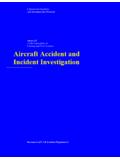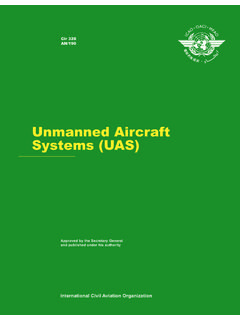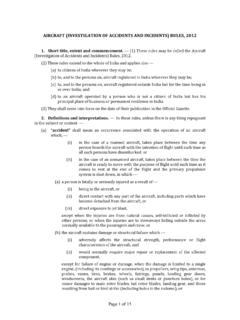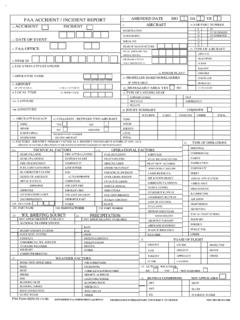Transcription of 5. CROSS-CULTURAL FACTORS IN AVIATION SAFETY
1 5. CROSS-CULTURAL FACTORS INAVIATION SAFETY Ashleigh Merritt and Daniel MaurinoABSTRACTThis paper presents the SAFETY case for the consideration of cross-culturalfactors in AVIATION by focusing on cultural interfaces, those situations wheremembers of one culture encounter people or artifacts from other AVIATION is strongly influenced by the USA and Western Europe asthe largest manufacturers and largest customers; hence almost all culturalinterfaces are weighted in favor of the dominant users. The challenge forsafetyisnottoignoreoreliminatethesein terfacesbuttomanagethepotentialthreats they pose.
2 To move forward, there is a role for those inside and outsidethe dominant no other technology before or since, AVIATION is responsible for creating the global village. It is now possible to reach any part of the world by air, and to doso in previously unimaginable time. Whereas international travel had previouslybeen a privilege of the wealthy elite or the adventurer, today s world is accessibleto more and more people. Business, leisure, even religious pilgrimages are nowachieved with the help of air travel. AVIATION has changed the way we think aboutthe world and what is possible in the world.
3 The contents of this chapter were originally developed to be included in a Human FACTORS Digest forthe International Civil AVIATION ErgonomicsAdvances in Human Performance and Cognitive Engineering Research ,Volume 4 ,147 181 2004 Published by Elsevier : 1479-3601/ (03)04005-0147148 ASHLEIGH MERRITT AND DANIEL MAURINOC ivil AVIATION is the global success that it is today because of its dedication toimproving SAFETY . This pursuit of improved standards has advanced the industryin several directions. First and foremost, brilliant minds have created ever moresophisticated machinery today s aircraft are extraordinary marvels achievingspeeds and load FACTORS never before imagined.
4 A second avenue of improvementhas focused on the human in the AVIATION system. Hawkins SHEL model placedthe human at the center of the AVIATION enterprise, and reminded us that thebest machinery must still be handled by humans (Hawkins & Orlady, 1993).Crew Resource Management (CRM) expanded the Human FACTORS horizon fromindividuals to teams (Wiener, Kanki & Helmreich, 1993), and Reason s model ofOrganizational accidents went one step further to show how policies and activitiesat the management level can impact SAFETY -related activities throughout an airline,including in the cockpit (Reason, 1997).
5 This dedication to improving SAFETY hasled to the investigation of CROSS-CULTURAL FACTORS in AVIATION is a prevailing way of doing business in global AVIATION that hasbeen shaped in large part by the manufacturers and the largest customers. Theindustry s standards and practices have been shaped via competitive deregulation,professional interest groups and resource-rich investment in technology. Theoutcome of this influence and investment is the outstanding SAFETY record that civilaviation now enjoys. Despite this overall success, some regions of the world donot enjoy the same high SAFETY record as others, prompting the inquiry as to standards and practices should be equally relevant, equally applied,equally enforced, and equally affordable around the world.
6 However, the SafetyOversight Audit Program of the International Civil AVIATION Organization (ICAO)has clearly demonstrated this is not the case (ICAO, 2000). Regional accidentrates vary dramatically around the globe, suggesting that the prevailing modelof AVIATION practice may not be equally applicable around the world. Under-standing these variable SAFETY statistics more completely was the impetus for paper presents the SAFETY case for the consideration of CROSS-CULTURAL factorsin AVIATION . It does so by focusing not on cultures per se but on cultural interfaces,those situations where members of one culture encounter people or artifacts fromother cultures.
7 Put at its most simple, as long as one stays within the bounds ofone s culture, all of the advantages of cultural membership hold; fellow membersand the environment are predictable, thereby making daily routines easier andquicker. But as soon as we encounter members or artifacts (aircraft, procedures,regulations) from other cultures, these cultural efficiencies are challenged and theopposite occurs: The environment becomes less predictable, more uncertain, andrequires more cognitive effort. In time, and with sufficient exposure, new habitsCross-Cultural FACTORS in AVIATION Safety149emerge to deal with the cultural interface.
8 In civil AVIATION today, cross-culturalcontact is the norm rather than the exception. In such a global context, culturalinterfaces are a daily illustrate the SAFETY case surrounding cultural interfaces, the paper buildsupon three existing industry conceptual models. First, Hawkins introduces thenotion of interfaces and notes their relevance for AVIATION Human , Reason s model of organizational accidents broadens the Human Factorshorizon to include organizational FACTORS distant from yet influential upon thecockpit.
9 The SAFETY case surrounding cultural interfaces in AVIATION seeks tobroaden the horizon even further, showing how members of one culture can incurconfusion, misunderstanding, and misapplication when encountering members orartifacts of another culture. In this sense, cultural interfaces can be seen as latentconditions. Lastly, the Threat and Error Management (TEM) Model (Helmreich,Klinect & Wilhelm, 1999) provides a framework for seeing the culturalinterface in the operating context. It can determine which types of culturalinterfaces are the most problematic for a specific context; it can also study thethreat management strategies employed by AVIATION personnel within specificcontexts to manage these interfaces.
10 Successful solutions can be shared with ,CONTEXT ,AND CULTURALINTERFACES IN AVIATIONIn a broad sense, culture can be defined as the ongoing interaction of a groupof people with their environment. The environment shapes the responses of thepeople, and the people s responses in turn modify the environment. A culturedevelops and changes due to three processes technological and physical changesin the environment; changes in the internal dynamics of the social system, andhistorical circumstances that are fortuitous or serendipitous (Fig.)










